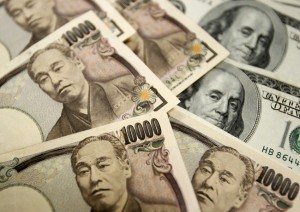 The yen trimmed daily gains against the US dollar after data showed Japans economy expanded at a slower-than-expected pace in the fourth quarter and the current account deficit widened to a record in January, fueling concerns over the nations economic outlook, before a sales-tax increase in April.
The yen trimmed daily gains against the US dollar after data showed Japans economy expanded at a slower-than-expected pace in the fourth quarter and the current account deficit widened to a record in January, fueling concerns over the nations economic outlook, before a sales-tax increase in April.
USD/JPY touched a session low at 102.94 at 07:05 GMT, after which the pair trimmed daily losses to trade little changed at 103.29 at 09:30 GMT, adding 0.03% for the day. Support was likely to be received at March 7th low, 102.84, while resistance was to be encountered at March 7th high, 103.76, also the pairs strongest since January 23rd.
Japans Cabinet Office reported today the nations gross domestic product expanded at an annualized 0.7% in the fourth quarter, less than a preliminary estimate of 1% and trailing analysts expectations for a 0.9% increase.
A separate report by the Ministry of Finance revealed the current account deficit widened to 1.59 trillion yen (approximately 15.4 billion US dollars), a record in data going back to 1985.
Moodys Investors Service reported last month that Japan is threatened to lose its position of a net creditor, which is one of its main credit strengths, if the nations current account continues to deteriorate for a prolonged period of time.
While economic growth is forecast to surge in this quarter ahead of the sales-tax increase in April, data from a sentiment survey released today, showed respondents expected a sharp pullback when consumers and companies face the higher levy.
Effective from April, the sales-tax will increase to 8% from the current level of 5%. The Japanese government already addressed the problem, by approving 5.5 trillion yen budget increase in December to offset the higher sales burden, but efforts seem insufficient as the Prime Minister Shinzo Abe is also expected to detail further growth measures in June to sustain momentum.
“Capital spending remains weak and exports are not coming back to strengthen the recovery, and without support in these areas, Japan’s economy is going to contract significantly in the second quarter,” said Yoshimasa Maruyama, chief economist at Itochu Corp. in Tokyo, cited by Bloomberg. “The negative effect from the sales tax rise could be worse than the BOJ and government expect.”
Bank of Japan, which started a two-day meeting today, will probably keep its main policy target of expanding the money supply by an annual pace of 60 trillion to 70 trillion yen per year.
In February, Bank of Japan kept its pledge to expand the money supply by an annual 60 trillion yen to 70 trillion yen and announced Japan’s banks may borrow twice as much low-interest money than they previously did under a second facility.
Thirty-eight percent of 34 economists in a Bloomberg News Survey, conducted from February 26 to March 4, predicted the central bank will add to stimulus by the end of June, to keep the worlds third largest economy on track for a 2% inflation target.
Japan, which is in a process of recovery after a 15-year period of deflation, boosted its economic growth in 2013, following unprecedented central bank’s stimulus, which devalued the yen by 18% against the US dollar, the most since 1979.
Meanwhile, the greenback was supported on Friday after the Bureau of Labor Statistics in the US reported that nations employers managed to add 175 000 workers to payrolls in February, after a revised up 129 000 increase in the previous month. Analysts had expected a 149 000 advance in February. At the same time, the unemployment rate unexpectedly rose to 6.7% last month from a 5-year low of 6.6% as more Americans entered the workforce, but couldn’t find a job. The US added 194 000 jobs on average, each month last year.
The report suggested that US employers were upbeat about the economic outlook, after recent winter storms and much-below-normal temperatures across the US and especially across the eastern parts of the country, slowed consumer spending, housing and manufacturing.
“The fundamentals are good,” Joe LaVorgna, chief U.S. economist at Deutsche Bank Securities Inc. in New York, commented in a Bloomberg interview before the report. “Faster job growth means faster income and more discretionary spending. Ultimately, with more business spending, not only will they hire more people, they’ll hire more capital. Everything becomes self-reinforcing.”
At the same time, the deficit on United States’ trade balance widened insignificantly to reach 39.1 billion USD in January, after in December the deficit figure has been revised to 38.975 billion USD from 38.701 billion USD previously. Analysts had anticipated a deficit at the amount of 38.500 billion USD in January.
Factors behind this wider deficit have been the weaker fuel export and the increased import of oil. A larger trade deficit usually causes an adverse impact upon economic growth. Imports rose 0.6% to reach 231.6 billion USD in January, while overall export increased also by 0.6% to reach 192.5 billion USD during the same month.
Elsewhere, AUD/USD touched a daily low at 0.9023 at 7:03 GMT, after which consolidation followed at 0.9027, falling 0.47% for the day. Support was likely to be received at psychological level of 0.9000, while resistance was to be encountered at March 7th high, 0.9134.





